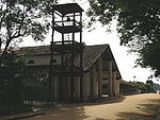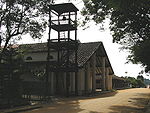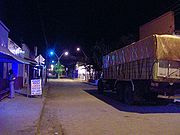
San Pedro, Paraguay
Encyclopedia
San Pedro de Ycuamandiyú is a city in Paraguay
. It is the capital of the department of San Pedro.
The conquistador
Alejo García
who was the first Europe
an to cross Paraguay and reach the Inca empire in 1524 was killed in San Pedro on his return.
to establish a small village in that place.
, 15 km (9 mi) from Antequera
district and 3 km (2 mi) from Jejui River.

, cotton
, soy, bean
, potato
, alfalfa
, cítricos, maní
, manioc and wheat
. Industries like wood, oil and petit grain. Craftmanship like embroidering ao poi and handed-works on clay.

The church was built during Don Carlos Antonio López government and rebuilt with all the characteristics of that period. The altarpiece and the images are invaluable parts of the Paraguayan History. Some important historical elements of the region can be seen at Mr. Francisco Resquin's museum.
Casa de la Cultura is another interesting place because artists present their works there, poems, guitar and music courses are held in this house.
Jejui River offers its shores and beach for people where they can go camping.
Paraguay
Paraguay , officially the Republic of Paraguay , is a landlocked country in South America. It is bordered by Argentina to the south and southwest, Brazil to the east and northeast, and Bolivia to the northwest. Paraguay lies on both banks of the Paraguay River, which runs through the center of the...
. It is the capital of the department of San Pedro.
The conquistador
Conquistador
Conquistadors were Spanish soldiers, explorers, and adventurers who brought much of the Americas under the control of Spain in the 15th to 16th centuries, following Europe's discovery of the New World by Christopher Columbus in 1492...
Alejo García
Alejo García
Aleixo Garcia, also Alejo García was a Portuguese-born explorer and conquistador who explored the Rio de la Plata in service to Spain, and later the Paraguay and Bolivia....
who was the first Europe
Europe
Europe is, by convention, one of the world's seven continents. Comprising the westernmost peninsula of Eurasia, Europe is generally 'divided' from Asia to its east by the watershed divides of the Ural and Caucasus Mountains, the Ural River, the Caspian and Black Seas, and the waterways connecting...
an to cross Paraguay and reach the Inca empire in 1524 was killed in San Pedro on his return.
Etymology
Originally the name was “Villa de San Pedro Apóstol de ykuaminday”, San Pedro's village from the water source of the cotton field, is the translation of the words in Guaraní Language “ykua” water source and “mandyju” cotton, there was a cotton plant in a well. Mr. Pedro García Lacoizqueta was sent by Governor Pedro Melo de PortugalPortugal
Portugal , officially the Portuguese Republic is a country situated in southwestern Europe on the Iberian Peninsula. Portugal is the westernmost country of Europe, and is bordered by the Atlantic Ocean to the West and South and by Spain to the North and East. The Atlantic archipelagos of the...
to establish a small village in that place.
Geography
Route XI “Juana de Lara” links the city to Route III "Elizardo Aquino" to the east. It is 25 km (16 mi) far from Paraguay RiverParaguay River
The Paraguay River is a major river in south central South America, running through Brazil, Bolivia, Paraguay, and Argentina...
, 15 km (9 mi) from Antequera
Antequera District
Antequera is a district of the San Pedro Department, Paraguay with Puerto Antequera the main location at the Paraguay River. It is an agricultural region. Its location is as follows: Latitude -24.1333 Longitude -57.0833 Altitude 64 meters. Puerto Antequera has 1,632 inhabitants....
district and 3 km (2 mi) from Jejui River.
Weather
The weather is humid and rainy, humidity ranges from 70 to 80%. The average temperature 23 °C, the maximum in summer is 35 °C and the minimum 10 °C.Demography
San Pedro's population is 29,097 inhabitants, 15,043 are men and 14,054 women. In the urban area 7,927 people and the rural area, 21,170 people.History
In 1525, native people might have killed the Portuguese Alejo García, who was the first person who discovered Paraguay walking the whole Chaco Paraguayo, he also went through the Tapé Avirú.
Economy
The city economy is based mainly on cattle rising. Farming includes yerba mateYerba mate
Maté, yerba maté or erva maté , Ilex paraguariensis, is a species of holly native to subtropical South America in northeastern Argentina, Bolivia, southern Brazil, Uruguay and Paraguay...
, cotton
Cotton
Cotton is a soft, fluffy staple fiber that grows in a boll, or protective capsule, around the seeds of cotton plants of the genus Gossypium. The fiber is almost pure cellulose. The botanical purpose of cotton fiber is to aid in seed dispersal....
, soy, bean
Bean
Bean is a common name for large plant seeds of several genera of the family Fabaceae used for human food or animal feed....
, potato
Potato
The potato is a starchy, tuberous crop from the perennial Solanum tuberosum of the Solanaceae family . The word potato may refer to the plant itself as well as the edible tuber. In the region of the Andes, there are some other closely related cultivated potato species...
, alfalfa
Alfalfa
Alfalfa is a flowering plant in the pea family Fabaceae cultivated as an important forage crop in the US, Canada, Argentina, France, Australia, the Middle East, South Africa, and many other countries. It is known as lucerne in the UK, France, Australia, South Africa and New Zealand, and known as...
, cítricos, maní
Peanut
The peanut, or groundnut , is a species in the legume or "bean" family , so it is not a nut. The peanut was probably first cultivated in the valleys of Peru. It is an annual herbaceous plant growing tall...
, manioc and wheat
Wheat
Wheat is a cereal grain, originally from the Levant region of the Near East, but now cultivated worldwide. In 2007 world production of wheat was 607 million tons, making it the third most-produced cereal after maize and rice...
. Industries like wood, oil and petit grain. Craftmanship like embroidering ao poi and handed-works on clay.

Tourism
San Pedro is the “Capital of Cordiality", because of the hospitality of its people. The most beautiful things are the ancient and colorful houses from the colonial period which can be appreciated in the city.The church was built during Don Carlos Antonio López government and rebuilt with all the characteristics of that period. The altarpiece and the images are invaluable parts of the Paraguayan History. Some important historical elements of the region can be seen at Mr. Francisco Resquin's museum.
Casa de la Cultura is another interesting place because artists present their works there, poems, guitar and music courses are held in this house.
Jejui River offers its shores and beach for people where they can go camping.
External links
- SENATUR
- World Gazeteer: Paraguay – World-Gazetteer.com

